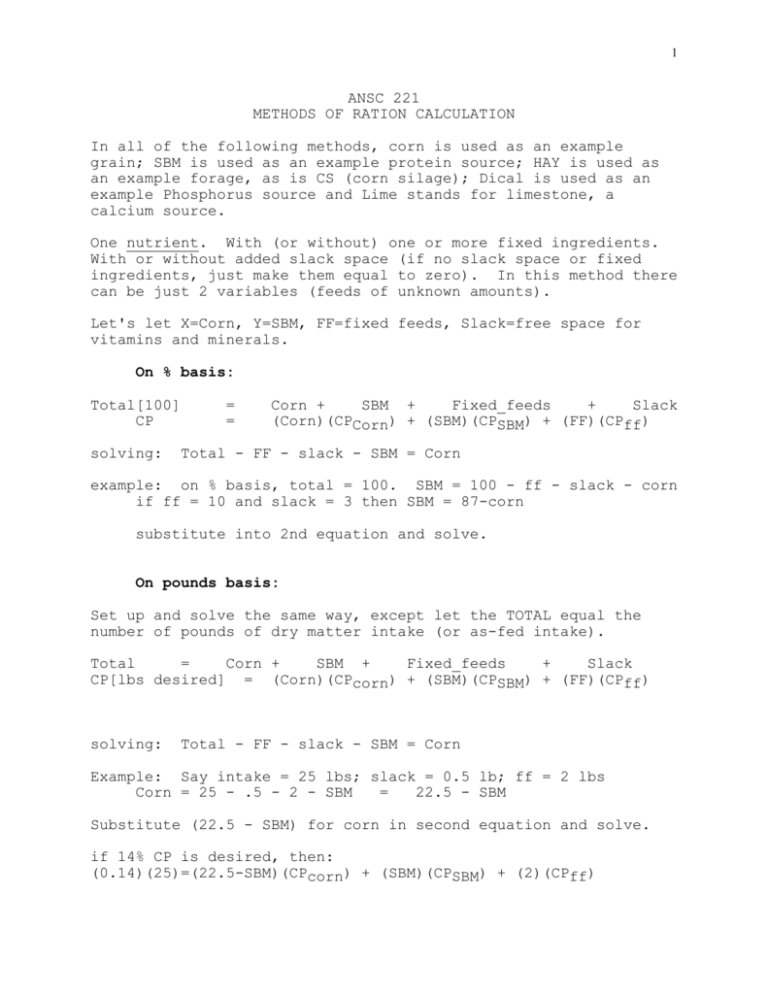How to calculate (word7 document)
advertisement

1 ANSC 221 METHODS OF RATION CALCULATION In all of the following methods, corn is used as an example grain; SBM is used as an example protein source; HAY is used as an example forage, as is CS (corn silage); Dical is used as an example Phosphorus source and Lime stands for limestone, a calcium source. One nutrient. With (or without) one or more fixed ingredients. With or without added slack space (if no slack space or fixed ingredients, just make them equal to zero). In this method there can be just 2 variables (feeds of unknown amounts). Let's let X=Corn, Y=SBM, FF=fixed feeds, Slack=free space for vitamins and minerals. On % basis: Total[100] CP solving: = = Corn + SBM + Fixed_feeds + Slack (Corn)(CPCorn) + (SBM)(CPSBM) + (FF)(CPff) Total - FF - slack - SBM = Corn example: on % basis, total = 100. SBM = 100 - ff - slack - corn if ff = 10 and slack = 3 then SBM = 87-corn substitute into 2nd equation and solve. On pounds basis: Set up and solve the same way, except let the TOTAL equal the number of pounds of dry matter intake (or as-fed intake). Total = Corn + SBM + Fixed_feeds + Slack CP[lbs desired] = (Corn)(CPcorn) + (SBM)(CPSBM) + (FF)(CPff) solving: Total - FF - slack - SBM = Corn Example: Say intake = 25 lbs; slack = 0.5 lb; ff = 2 lbs Corn = 25 - .5 - 2 - SBM = 22.5 - SBM Substitute (22.5 - SBM) for corn in second equation and solve. if 14% CP is desired, then: (0.14)(25)=(22.5-SBM)(CPcorn) + (SBM)(CPSBM) + (2)(CPff) 2 Solving for MORE than 1 NUTRIENT Adding extra nutrients means adding extra equations, and solving them simultaneously Let's let X=corn, Y=SBM, Z=hay eg: 100 = X + Y + Z CP = X(CPX) +Y(CPY) + Z(CPZ) TDN = (X)(TDNX) + (Y)(TDNY) + (Z)(TDNz) Solve this equation set to find the amounts of X, Y and Z. NOTE: You must have exactly 3 feeds to solve for 3 equations. If you add another nutrient, you must add another equation. You cannot have more feeds in unknown amounts. (You could deal with fixed amounts of feeds and slack space, however). Solving with INEQUALITIES LINEAR PROGRAMMING LEAST COST SOLUTIONS It is not a complicated additional step to set up the equations for least-cost solutions. Solving the equation set is harder, we'll let a computer program do that. Conceptually, the equation set could be: X + Y + Z = X(CPX) +Y(CPY) + Z(CPZ) > (X)(TDNX) + (Y)(TDNY) + (Z)(TDNz) > 100 CP TDN and we must have a decision function (PRICE) for each feed. X($X) Y($Y) Z($Z) Another difference is that now we could have a great number of feeds, not just exactly the same number as 'non-trivial equations' that we have. And the solution would use just the feeds that make up the least-cost solution, in the correct amounts. In all the equations above, we could have had fixed amounts of feeds (FF) and add that term as appropriate, and the nutrient content of FF, to each line in the sets of equations. 3 Solving Simultaneous Equations by Matrix Methods Using matrix algebra gives us a very powerful method of solving simultaneous equations with the aid of a computer. QUATTRO, for example, will solve matrix problems and some programming languages (such as certain BASIC's) do also. Let the requirements (also called restrictions) be represented by R. R is a matrix of n rows and 1 column, where n=the number of requirements. Example: ┌ ┐ │TOTAL│ │CP │ │TDN │ └ ┘ R Let the feedstuffs analysis values be placed in a matrix represented by C. C is a matrix of n rows and n columns, where n=the number of nutrients which also must = the number of requirements. Example: C ┌ ┐ │1 1 1 │ │CP1 CP1 CP1 │ │TDN1 TDN1 TDN1│ └ ┘ Let the feedstuff amounts, the answers, be represented by B. Example: B Then, in matrix notation, Therefore: ┌ ┐ │Feed1│ │Feed2│ │Feed3│ └ ┘ R = B C B = C-1 R In other words, to get the amount of each feed to feed, just multiply the inverse of C (the composition table) by R (the requirements). Precaution. This method, just as all simultaneous equations methods, gives exact solutions mathematically, without regard to practicality. Negative numbers are possible, even though they make no sense nutritionally. 4 OTHER PRACTICAL METHODS OF RATION BALANCING When exact solutions for 2 nutrients are not required, but the requirement for 2 nutrients must be met or exceeded, you can use the following method which requires some judgement and decision on your part. Start by estimating the feed intake of the animal. It is important that you balance a ration that is realistic in terms of expected feed intake. Choose a fixed amount of forage to feed. You might choose one-half or three-forths of the expected dry matter intake, for example. Calculate the contribution toward the requirements provided by the forage and figure how much Protein and Energy you still need. Using an average ENERGY value for the concentrate you will feed, calculate the pounds of concentrate you will have to feed to meet the energy requirement. (ie, divide the TDN reqd by the avg TDN in the concentrate mix). Finally, balance the concentrate (between corn and SBM, for example), to provide the additional protein (if any) is still needed. EXAMPLE: A 1000 lb beef cow requiring about 20 lbs dry matter needs 10.5 lbs TDN and 1.6 lbs CP. I choose to feed 1.25% of the cow's body weight as forage (expected DM intake = 1.5 to 2.25). The forage I'll use is Timothy Hay (9% CP, 56% TDN). 1000 lb X .0125 = 12.5 lbs timothy hay. 12.5 X .09 = 1.125 lb CP Rqmt still needed 1.6 - 1.125 = .475 CP 12.5 X .56 = 7 10.5 - 7 lb TDN = 3.5 TDN Let's assume our concentrate mix will average 78% TDN. (We can't know exactly before-hand; estimate). 3.5 divided by .78 = 4.48 lbs concentrate mix. What percent protein should our concentrate mix be? .475 lb CP divided by 4.48 lbs of feed = 10.6 % CP. (4.48)(.106)=(x)(.08)+(4.48-x)(.44) x=corn, 4.48-x=SBM .475=.08x - 1.9172 - .44x 0.08=% CP in Corn, -1.496 = -.36x 0.44=%CP in SBM 4.16 = x = corn; 4.48-x= 0.32 lb = SBM 5 HOW TO CALCULATE DRY MATTER AND AS-FED To calculate the amount of dry matter from the concentration of dry matter in a feed, take: (Feed Amount as-fed, lbs) times (% DM) = Lbs of dry matter. Example: you feed 25 lbs and it is 90% DM. matter did you feed? 25 X .9 = 22.5 How many lbs of dry To calculate the amount of as-fed (read: WET) feed from the dry matter amount and the %DM in the as-fed feed: Think: (X lbs of as-fed feed) (%DM) = dry matter, lbs Lbs DM ---------%DM = Lbs of AS-FED FEED Example: You feed 20 lbs of corn silage dry matter and corn silage has 30% DM. How much feed do you weigh out to feed? 20 --.30 = 66.7 lbs. THAT's a LOT, isn't it. Remember corn silage is 2/3 water. (well, really 70% in this example) HOW TO CALCULATE DIGESTION COEFFICIENTS AND TDN DIGESTION COEFFICIENTS must be determined for CP, NFE, CF, and EE portions of the feed sample to determine TDN. In some digestion trials, we may also want to determine the digestion coefficients for dry matter and sometimes ash as well. However, the digestibility of DM and ASH is not necessary to determine TDN. Digestion coefficients are most commonly expressed on a percentage basis. The digestion coeffficient (% Digestibility) can be calculated for any nutrient by the following equation: (TOTAL NUTRIENT CONSUMED - TOTAL NUTRIENT EXCRETED % DIGESTIBILITY = ______________________________________________ X 100 TOTAL NUTRIENT CONSUMED EXAMPLE CALCULATION Say the Nitrogen content of a feed is 2%. If the animal eats 400g then the total N consumed is 400 X .02 = 8g. If the amount of N in the feces was 3% and the animal excreted 50g of feces the total N excreted in feces would be 50 X .03 = 1.5g. The % N digestibility would be (8 - 1.5) / 8 X 100 = 81.25% This example gave only APPARENT nitrogen digestibility. To determine TRUE nitrogen digestibility, you would have to know how much of the N in the feces was of endogenous origin. If you did know that the endogenous portion in the example above was 0.5% (of the 3% in the feces), then for true N digestibility, correct the fecal N value: True N Digestibility = Nfeed - (NFeces - endogenous N) --------------------------------Nfeed or for the example above (8 - (1.5 - 0.25)) / 8 = 84.375% X100 = 84.4% The 0.25 comes for multiplying .005 times the 50g of feces. NITROGEN BALANCE AND NITROGEN RETENTION: These two terms are often used interchangably, but it is harder to envision negative nitrogen retention than it is negative nitrogen balance (whether the animal is losing or gaining nitrogen). Often nitrogen balance is expressed in amount (grams) whereas nitrogen retention is expressed as a percentage. To determine these values you need the total N intake (the source is feed) minus the total N excretion (the main sources are feces and urine). Using the example above, and including a N loss in urine of 2 g, the NITROGEN BALANCE would be + 4.5g N (8g - 1.5g - 2g). This is sometimes called nitrogen retention when the value is positive. BIOLOGICAL VALUE B.V. is a measure of the protein quality of a feed. It is determined as the proportion of protein retained as a % of that digested. It is calculated as: Nfeed - Nfeces - Nurine ----------------------Nfeed -Nfeces X 100 Using the previous data, the value would be 8g -1.5g -2g ------------- = (8g -1.5g) 69.2% That is APPARENT B. V. As before, if you had correction factors for endogenous N in the feces (MFN for metabolic fecal nitrogen) and urine (EUN for endogenous urinary nitrogen), then you would make those corrections: True B.V. = Nfeed - (Nfeces - MFN) - (Nurine - EUN) ----------------------------------------Nfeed - (Nfeces - MFN) X 100 EXAMPLE: If MFN = 0.5g and EUN = .4g then: True B.V. = 8 - (1.5 - 0.5) - (2 - 0.4) 8 - 1 - 1.6 --------------------------- ------------ = 77.1% 8 - (1.5 - 0.5) 8 - 1 TDN TDN represents ENERGY based on a carbohydrate equivalent basis. TDN stands for total digestible nutrients. I suggest you ignore that as irrelevent and misleading; it represents ENERGY. TDN is calculated as the digestible CP, Crude Fiber, NFE and EE X 2.25 added together. IE, take the proximate analysis values for the things that contain energy: crude protein, crude fiber, ether extract, and NFE. Multiply each times their digestibility, and fat times 2.25, and add the values. Example: % Water CP EE CF ASH NFE total 15 18 9 35 4 19 --100 ENERGY 0 1 2.25 1 0 1 Digestibility .85 .8 .6 = = = 15.3 16.2 21 .8 = 15.2 ---67.7 DE, ME, NE Digestible energy is the gross energy minus energy in the feces. Multiply the kcal/g times the g of feed eaten to get energy consumed; multiply the kcal/g times the g of feces excreted to get energy excreted in the feces. Metabolisable energy is the digestible energy minus energy in the urine (and gasseous loss of ruminants). Net energy is metabolisable energy minus HEAT INCREMENT.


